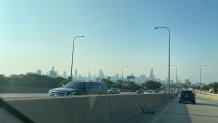How long could air quality alerts due to the Canadian wildfires go on for the Chicago area?
The region has been hit multiple times with alerts due to "unhealthy" smoke levels in the air so far this summer and, unfortunately, NBC 5 Storm Team Meteorologist Pete Sack said the answer depends on the wildfires themselves.
"The frequency is going to depend a lot on, of course, the wildfires and how bad they're burning," Sack said. "The other factor is the upper level winds."
Sack said winds from the northwest are pulling smoke from Canadian wildfires into the Midwest, but the latest round is different from the air quality alerts that plagued the region at the start of July. Those winds came from the northeast.
"As long as the upper level patterns are favorable to bring that air into us, we're going to continue to see air quality alerts," Sack said.
The entire Chicago area was under an air quality alert once again Monday due to Canadian wildfires.
"There are Air Quality alerts issued for areas the include the northern High Plains, the Midwest, Great Lakes, central Tennessee and North Carolina, and into the Northeast where higher concentrations of smoke will result in unhealthy air quality for sensitive groups," the National Weather Service said. "Smoke concentrations should diminish over parts of the Heartland on Tuesday, but may still cause poor air quality along the East Coast."
Local
Wildfires raging across Canada have broken records for total area burned and have been affecting air quality in the U.S. and Canada.
According to the Illinois Environmental Protection Agency, the alert will remain in effect until midnight.
Feeling out of the loop? We'll catch you up on the Chicago news you need to know. Sign up for the weekly Chicago Catch-Up newsletter here.
According to the government website AirNow, Chicago's air quality continued to register at "unhealthy" levels Monday morning, a level four on a six-level scale.
As of 8 a.m. Monday, the city's PM2.5 -- an air pollutant also known as fine particulate matter -- registered at 154. Anything over 200 is considered "very unhealthy," officials said. But by 3 p.m., levels had dropped dramatically, down to a 55, or a "moderate" level.
When the air quality is classified as "unhealthy," those with respiratory conditions, as well as active children and teenagers, are encouraged to avoid strenuous outdoor activities, to keep any outdoor activities short, and to consider moving activities indoors.
Others are also encouraged to choose less-strenuous activities outdoors, and to shorten time spent outside.

The alert comes weeks after smoke and haze from Canadian wildfires blanketed the Chicago area for several days resulting in canceled events, closed beaches, flight cancellations and more.
Saturday, Chicago Mayor Brandon Johnson warned residents that air quality alerts were expected to continue into the work week and said the city was "closely monitoring any worsening air conditions."
"We are acutely aware that the recent weather events prominently impacting our City this summer are the direct result of the climate crisis," Johnson said in a tweet. "We will take every effort to protect our community from these immediate threats and mitigate ongoing impacts through robust climate actions."
What is an unhealthy air quality level?
AirNow said its air quality index determines the level of air pollution and the correlating health concerns.
"When AQI values are above 100, air quality is unhealthy: at first for certain sensitive groups of people, then for everyone as AQI values get higher," the website states.
Once Chicago reaches above 300, it enters the highest level of concern known as "hazardous."
In total, there are six categories: green, or good; yellow, or moderate; orange, or unhealthy for sensitive groups; red, or unhealthy; purple, or very unhealthy; and maroon, or hazardous.
| Daily AQI Color | Levels of Concern | Values of Index | Description of Air Quality |
|---|---|---|---|
| Green | Good | 0 to 50 | Air quality is satisfactory, and air pollution poses little or no risk. |
| Yellow | Moderate | 51 to 100 | Air quality is acceptable. However, there may be a risk for some people, particularly those who are unusually sensitive to air pollution. |
| Orange | Unhealthy for Sensitive Groups | 101 to 150 | Members of sensitive groups may experience health effects. The general public is less likely to be affected. |
| Red | Unhealthy | 151 to 200 | Some members of the general public may experience health effects; members of sensitive groups may experience more serious health effects. |
| Purple | Very Unhealthy | 201 to 300 | Health alert: The risk of health effects is increased for everyone. |
| Maroon | Hazardous | 301 and higher | Health warning of emergency conditions: everyone is more likely to be affected. |
What is PM2.5?
According to the Environmental Protection Agency, "PM stands for particulate matter (also called particle pollution): the term for a mixture of solid particles and liquid droplets found in the air."
"Some particles, such as dust, dirt, soot, or smoke, are large or dark enough to be seen with the naked eye. Others are so small they can only be detected using an electron microscope," the EPA states.
PM2.5 in particular involves "fine inhalable particles, with diameters that are generally 2.5 micrometers and smaller." By comparison, the average human hair strand is about 70 micrometers in diameter, or 30 times larger than these particles.
PM2.5 is one of five major air pollutants regulated by the Clean Air Act, which also includes ground-level ozone, carbon monoxide, sulfur dioxide and nitrogen dioxide.
What sparked the Canada wildfires?
According to the National Weather Service, some of the fires were ignited by lightning.
Much of the region also remains "abnormally dry" or under a "moderate drought." The fires started early on drier-than-usual ground and accelerated very quickly, exhausting firefighting resources across the country, fire and environmental officials said.
Officials have warned that there are more out of control fires than the SOPFEU can handle with available resources.
In early June, U.S. President Joe Biden said in a statement that hundreds of American firefighters and support personnel have been in Canada since May, and called attention to the fires as a reminder of the impacts of climate change.
The warming planet will produce hotter and longer heat waves, making for bigger, smokier fires, according to Joel Thornton, professor and chair of the department of atmospheric sciences at the University of Washington.



